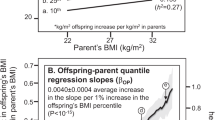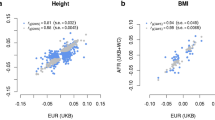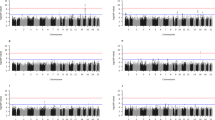Abstract
Objective:
To detect quantitative trait loci influencing adiposity-related phenotypes assessed by body mass index (BMI), abdominal circumference (ABDCIR), percent body fat (%BFAT) and fasting serum leptin and adiponectin using a whole genome linkage scan of families from American Samoa.
Design:
Family-based linkage analysis, the probands and family members were unselected for obesity.
Subjects:
A total of 583 phenotyped American Samoan adults, of which 578 were genotyped in 34 pedigrees.
Measurements:
A total of 377 autosomal and 18 X chromosome microsatellite markers were typed at an approximate average spacing of 10 cM spanning the genome. Multipoint LOD (logarithm of the odds) scores were calculated using variance-components approaches and SOLAR/LOKI software. The covariates simultaneously evaluated were age, sex, education, farm work and cigarette smoking, with a significance level of 0.1. Due to the stochastic nature of LOKI, we report the average of maximum LOD scores from 10 runs.
Results:
Significant linkage to leptin was found at 6q32.2 with LOD of 3.83. Suggestive linkage to leptin was found at 16q21:LOD=2.98, 1q42.2:LOD=1.97, 5q11.2:LOD=2.08, 12q24.23:LOD=2.00, 19p13.3:LOD=2.05; adiponectin was linked to 13q33.1–q22.1:LOD=2.41; %BFAT was linked to 16q12.2–q21, LOD=2.24; ABDCIR was linked to 16q23.1:LOD=1.95; %BFAT-adjusted leptin to 14q12, LOD=2.01; %BFAT-adjusted ABDCIR to 1q31.1, LOD=2.36, to 3q27.3–q28, LOD=2.10 and to 12p12.3, LOD=2.04.
Conclusion:
We found strong evidence for a major locus on 6q23.2 influencing serum leptin levels in American Samoans. The 16q21 region appears to harbor a susceptibility locus that has significant pleiotrophic effects on phenotypes BMI, %BFAT, leptin and ABDCIR as shown by bivariate linkage analyses. Several other loci of varying significance were detected across the genome.
This is a preview of subscription content, access via your institution
Access options
Subscribe to this journal
Receive 12 print issues and online access
$259.00 per year
only $21.58 per issue
Buy this article
- Purchase on Springer Link
- Instant access to full article PDF
Prices may be subject to local taxes which are calculated during checkout


Similar content being viewed by others
References
Hedley AA, Ogden CL, Johnson CL, Carroll MD, Curtin LR, Flegal KM . Prevalence of overweight and obesity among US children, adolescents, and adults, 1999-2002. JAMA 2004; 291: 2847–2850.
Popkin BM, Gordon-Larsen P . The nutrition transition: worldwide obesity dynamics and their determinants. Int J Obes Relat Metab Disord 2004; 28 (Suppl): S2–S9.
Bell CG, Walley AJ, Froguel P . The genetics of human obesity. Nat Rev Genet 2005; 6: 221–234.
Flegal KM, Carroll MD, Ogden CL, Johnson CL . Prevalence and trends in obesity among US adults, 1999–2000. JAMA 2002; 288: 1723–1727.
McGarvey ST . Obesity in Samoans and a perspective on the etiology in Polynesians. Am J Clin Nutr 1991; 53 (Suppl): S1586–S1594.
McGarvey ST . Cardiovascular disease (CVD) risk factors in Samoa and American Samoa, 1990–95. Pac Health Dialog 2001; 8: 157–162.
Keighley ED, McGarvey ST, Turituri P, Viali S . Farming and adiposity in Samoan adults. Am J Hum Biol 2006; 18: 112–122.
Keighley ED, McGarvey ST, Quested C, McCuddin C, Viali S, Maiava T . Nutrition and health in modernizing Samoans: temporal trends and adaptive perspectives. ED Keighley. In: Ohtsuka R and Ulijaszek SJ (eds) Health Change in the Asia-Pacific Region: Biocultural and Epidemiological Approaches. Cambridge University Press: Cambridge, UK, 2007. pp. 147–191.
Swinburn BA, Ley SJ, Carmichael HE, Plank LD . Body size and composition in Polynesians. Int J Obes 1999; 23: 1178–1183.
Rankinen T, Zuberi A, Chagnon YC, Weisnagel SJ, Argyropoulos G, Walts B et al. The human obesity gene map: the 2005 update. Obesity 2006; 14: 529–644.
Peltonen L, Palotie A, Lange K . Use of population isolates for mapping complex traits. Nat Rev Genet 2000; 1: 182–189.
McGarvey ST . The thrifty gene concept and adiposity studies in biological anthropology. J Polyn Soc 1994; 103: 29–42.
Galanis D, McGarvey ST, Quested C, Sio B, Afele-Fa'amuli S . Dietary intake among modernizing Samoans: implications for risk of cardiovascular disease. J Am Diet Assoc 1999; 99: 184–190.
Tsai HJ, Sun G, Smelser D, Viali S, Tufa J, Jin L et al. Distribution of genome-wide linkage disequilibrium based on microsatellite loci in the Samoan population. Hum Genomics 2004; 1: 327–334.
McGarvey ST, Levinson PD, Rausserman L, Galanis DJ, Hornick CA . Population change in adult obesity and blood lipids in American Samoa from 1976-1978 to 1990. Am J Hum Biol 1993; 5: 17–30.
Williams-Blangero S, Blangero J . Collection of pedigree data for genetic analysis in isolated populations. Hum Biol 2006; 78: 89–101.
Lohman TG, Roche AF, Martorell R . Anthropometric Standardization Reference Manual. Human Kinetics Press: Champaign, 1998.
Box GEP, Cox DR . An analysis of transformations revisited, rebutted. J Am Stat Assoc 1982; 77: 209–210.
Duren WL, Epstein M, Li M, Boehnke M . RELPAIR: a program that infers the relationships of pairs of individuals based on marker data. Version 2.0.1, June 2004.
McPeek MS, Sun L . Statistical tests for detection of misspecified relationships by use of genome-screen data. Am J Hum Genet 2000; 66: 1076–1094.
O'Connell JR, Weeks DE . PedCheck: a program for identification of genotype incompatibilities in linkage analysis. Am J Hum Genet 1998; 63: 259–266.
Heath SC . Markov chain Monte Carlo segregation and linkage analysis for oligogenic models. Am J Hum Genet 1997; 61: 748–760.
Mukhopadhyay N, Almasy L, Schroeder M, Mulvihill WP, Weeks DE . Mega2: data-handling for facilitating genetic linkage and association analyses. Bioinformatics 2005; 21: 2556–2557.
Kong X, Murphy K, Raj T, He C, White PS, Matise TC . A combined linkage-physical map of the human genome. Am J Hum Genet 2004; 75: 1143–1148.
Amos CI . Robust variance-components approach for assessing genetic linkage in pedigrees. Am J Hum Genet 1994; 54: 535–543.
Almasy L, Blangero J . Multipoint quantitative trait linkage analysis in general pedigrees. Am J Hum Genet 1998; 62: 1198–1211.
Self SG, Liang KY . Asymptotic properties of maximum likelihood estimators and likelihood ratio tests under non-standard conditions. J Am Stat Assoc 1987; 82: 605–610.
Allison DB, Neale MC, Zannolli R, Schork NJ, Amos CI, Blangero J . Testing the robustness of the likelihood-ratio test in a variance-component quantitative-trait loci-mapping procedure. Am J Hum Genet 1999; 65: 531–544.
Lander E, Kruglyak L . Genetic dissection of complex traits: guidelines for interpreting and reporting linkage results. Nat Genet 1995; 11: 241–247.
Zeegers M, Rijsdijk F, Sham P . Adjusting for covariates in variance components QTL linkage analysis. Behav Genet 2004; 34: 127–133.
Lange K . Mathematical and Statistical Methods for Genetic Analysis (2nd ed) Springer: New York, 2002.
Ekstrøm CT . Multipoint linkage analysis of quantitative traits on sex-chromosomes. Genet Epidemiol 2004; 26: 218–230.
Kent Jr JW, Dyer TD, Blangero J . Estimating the additive genetic effect of the X chromosome. Genet Epidemiol 2005; 29: 377–388.
Lange K, Sobel E . Variance component models for X-linked QTLs. Genet Epidemiol 2006; 30: 380–383.
Lange K, Cantor R, Horvath S, Perola M, Sabatti C, Sinsheimer J et al. Mendel version 4.0: a complete package for the exact genetic analysis of discrete traits in pedigree and population data sets. Am J Hum Genet 2001; 69 (Suppl): A1886.
Almasy L, Dyer TD, Blangero J . Bivariate quantitative trait linkage analysis: pleiotropy versus co-incident linkages. Genet Epidemiol 1997; 14: 953–958.
Williams JT, Van Eerdewegh P, Almasy L, Blangero J . Joint multipoint linkage analysis of multivariate qualitative and quantitative traits. I. Likelihood formulation and simulation result. Am J Hum Genet 1999; 65: 1134–1147.
Meyre D, Bouatia-Naji N, Tounian A, Samson C, Lecoeur C, Vatin V et al. Variants of ENPP1 are associated with childhood and adult obesity and increase the risk of glucose intolerance and type 2 diabetes. Nat Genet 2005; 37: 863–867.
Meyre D, Froguel P . ENPP1, the first example of common genetic link between childhood and adult obesity and type 2 diabetes. Med Sci (Paris) 2006; 22: 308–312.
Duggirala R, Blangero J, Almasy L, Arya R, Dyer TD, Williams KL et al. A major locus for fasting insulin concentrations and insulin resistance on chromosome 6q with strong pleiotropic effects on obesity-related phenotypes in nondiabetic Mexican Americans. Am J Hum Genet 2001; 68: 1149–1164.
Ghosh S, Watanabe RM, Valle TT, Hauser ER, Magnuson VL, Langefeld CD et al. The Finland-United States Investigation of Non-Insulin-Dependent Diabetes Mellitus Genetics (FUSION) Study: I. An autosomal genome scan for genes that predispose to type 2 diabetes. Am J Hum Genet 2000; 67: 1174–1185.
Watanabe RM, Ghosh S, Langefeld CD, Valle TT, Hauser ER, Magnuson VL et al. The Finland-United States Investigation of Non-Insulin-Dependent Diabetes Mellitus Genetics study II. An autosomal genome scan for diabetes-related quantitative trait loci. Am J Hum Genet 2000; 67: 1186–1200.
Meyre D, Lecoeur C, Delplanque J, Francke S, Vatin V, Durand E et al. A genome-wide scan for childhood obesity-associated traits in French families shows significant linkage on chromosome 6q22.31–q23.2. Diabetes 2004; 53: 803–811.
Wu X, Cooper RS, Borecki I, Hanis C, Bray M, Lewis CE et al. A combined analysis of genomewide linkage scans for body mass index from the National Heart, Lung, and Blood Institute Family Blood Pressure Program. Am J Hum Genet 2002; 70: 1247–1256.
Geller F, Dempfle A, Gorg T . Genome scan for body mass index and height in the Framingham Heart Study families. BMC Genet 2003; 1 (Suppl): S91.
Wu X, Luke A, Cooper RS, Zhu X, Kan D, Tayo BO et al. A genome scan among Nigerians linking resting energy expenditure to chromosome 16. Obes Res 2004; 12: 577–581.
Tanizawa Y, Riggs AC, Dagogo-Jack S, Vaxillaire M, Froguel P, Liu L et al. Isolation of the human LIM/homeodomain gene islet-1 and identification of a simple sequence repeat 1. Diabetes 1994; 43: 935–941.
Feitosa MF, Borecki IB, Rich SS, Arnett DK, Sholinsky P, Myers RH et al. Quantitative-trait loci influencing body-mass index reside on chromosomes 7 and 13: the National Heart, Lung, and Blood Institute Family Heart Study. Am J Hum Genet 2002; 70: 72–82.
Chen W, Li S, Cook NR, Rosner BA, Srinivasan SR, Boerwinkle E, Berenson GS . An autosomal genome scan for loci influencing longitudinal burden of body mass index from childhood to young adulthood in white sibships: the Bogalusa Heart Study. Int J Obes Relat Metab Disord 2004; 28: 462–469.
Li WD, Dong C, Li D, Zhao H, Price RA . An obesity-related locus in chromosome region 12q23-24. Diabetes 2004; 53: 812–820.
Yamagata K, Oda N, Kaisaki PJ, Menzel S, Furuta H, Vaxillaire M et al. Mutations in the hepatocyte nuclear factor-1alpha gene in maturity-onset diabetes of the young (MODY3). Nature 1996; 384: 455–457.
Frayling TM, Bulamn MP, Ellard S, Appleton M, Dronsfield MJ, Mackie AD et al. Mutations in the hepatocyte nuclear factor-1alpha gene are a common cause of maturity-onset diabetes of the young in the UK. Diabetes 1997; 46: 720–725.
Ellard S . Hepatocyte nuclear factor 1 alpha (HNF-1 alpha) mutations in maturity-onset diabetes of the young. Hum Mutat 2000; 16: 377–385.
Norris JM, Langefeld CD, Scherzinger AL, Rich SS, Bookman E, Beck SR et al. Quantitative trait loci for abdominal fat and BMI in Hispanic-Americans and African-Americans: the IRAS Family study. Int J Obes 2005; 29: 67–77.
Toplak H, Haller EM, Lauermann T, Weber K, Bahadori B, Reisinger EC et al. Increased prevalence of IgA-Chlamydia antibodies in NIDDM patients. Diabetes Res Clin Pract 1996; 32: 97–101.
Hsueh WC, Mitchell BD, Schneider JL, St Jean PL, Pollin TI, Ehm MG et al. Genome-wide scan of obesity in the old order Amish. J Clin Endocrinol Metab 2001; 86: 1199–1205.
Ohman M, Oksanen L, Kaprio J, Koskenvuo M, Mustajoki P, Rissanen A et al. Genome-wide scan of obesity in Finnish sibpairs reveals linkage to chromosome Xq24. J Clin Endocrinol Metab 2000; 85: 3183–3190.
Suviolahti E, Oksanen LJ, Ohman M, Cantor RM, Ridderstrale M, Tuomi T et al. The SLC6A14 gene shows evidence of association with obesity. J Clin Invest 2003; 112: 1762–1772.
Deng HW, Deng H, Liu YJ, Liu YZ, Xu FH, Shen H et al. A genomewide linkage scan for quantitative-trait loci for obesity phenotypes. Am J Hum Genet 2002; 70: 1138–1151.
Martin LJ, Cole SA, Hixson JE, Mahaney MC, Czerwinski SA, Almasy L et al. Genotype by smoking interaction for leptin levels in the San Antonio Family Heart Study. Genet Epidemiol 2002; 22: 105–115.
Acknowledgements
Our work is supported by NIH grant R01-DK59642 (ST M, PI). Karolina Åberg was supported by The American Scandinavia Foundation and by The Knut and Alice Wallenberg's fund. We thank the fieldwork team of students and local assistants for their hard work in American Samoa in 2002. We thank the leaders of the American Samoa Department of Health for their support and the local political officials for their permission to work in the villages. We are grateful to the families and study participants for their contributions to this research.
Author information
Authors and Affiliations
Corresponding author
Additional information
Authors' contributions FD, under the supervision of DEW, carried out the primary statistical analyses of the data and wrote much of the manuscript. EDK, under the supervision of STM, performed all phenotype data management and checking and correction of the reported pedigrees. GS, SRI and DS, under the supervision of RD, performed DNA extraction, genotyping of all markers, data cleaning and transfer of data to the laboratory of DEW. STR, under the supervision of STM, was field director, and performed initial data management of phenotypic and pedigree data. KÅ, under the supervision of DEW, reanalyzed the data independently, and so provided valuable double checks that our analyses were done correctly. JT provided guidance in conduct of the fieldwork. RD and LJ participated in the designing the molecular work, quality control, data-management and supervised the analysis of the raw genotyping data. STM, RD and DEW collaboratively designed and led this study and obtained funding for it. All the authors read and approved the final manuscript.
Supplementary information accompanies the paper on International Journal of Obesity web site (http://www.nature.com/ijo)
Supplementary information
Rights and permissions
About this article
Cite this article
Dai, F., Keighley, E., Sun, G. et al. Genome-wide scan for adiposity-related phenotypes in adults from American Samoa. Int J Obes 31, 1832–1842 (2007). https://doi.org/10.1038/sj.ijo.0803675
Received:
Revised:
Accepted:
Published:
Issue Date:
DOI: https://doi.org/10.1038/sj.ijo.0803675
Keywords
This article is cited by
-
Genome-wide association studies in Samoans give insight into the genetic architecture of fasting serum lipid levels
Journal of Human Genetics (2021)
-
Profound Obesity Secondary to Hyperphagia in Mice Lacking Kinase Suppressor of Ras 2
Obesity (2011)
-
Suggestive linkage detected for blood pressure related traits on 2q and 22q in the population on the Samoan islands
BMC Medical Genetics (2009)
-
Susceptibility Loci for Adiposity Phenotypes on 8p, 9p, and 16q in American Samoa and Samoa
Obesity (2009)
-
Candidate genes for obesity revealed from a C57BL/6J × 129S1/SvImJ intercross
International Journal of Obesity (2008)



